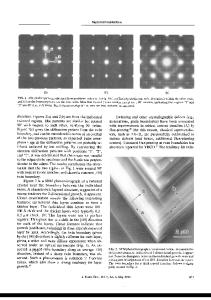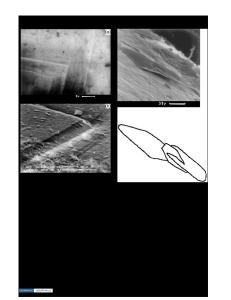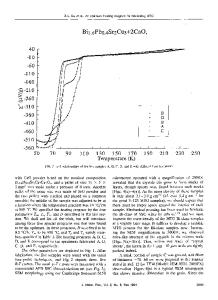Crystal growth of Bi 2 Sr 2 Ca 2 Cu 3 O 10+x and (Bi,Pb) 2 Sr 2 Ca 2 Cu 3 O 10+x by the KCl flux method
- PDF / 205,542 Bytes
- 8 Pages / 612 x 792 pts (letter) Page_size
- 71 Downloads / 397 Views
Bi2Sr2Ca2Cu3O10+x and (Bi,Pb)2Sr2Ca2Cu3O10+x single crystals with a sharp superconducting transition at Tc ⳱ 109 K were grown using a modified KCl flux technique. The crystals show platelike morphology with typical dimensions of 0.5 × 0.5 × 0.002 mm3 and 0.25 × 0.25 × 0.001 mm3 for Pb-free and Pb-doped compositions, respectively. The formation of Bi-2212 intergrowth in the crystals is suppressed by utilization of a stable MgO crucible, suppression of the KCl evaporation, and isothermal heat treatment at a temperature close to the melting temperature of the oxide precursor in the flux. Morphology, phase purity, and chemical composition of grown crystals were determined by various analysis methods while the superconducting properties were studied by magnetization and resistivity measurements.
I. INTRODUCTION
After the discovery of superconductivity in the Bi–Sr– Ca–Cu–O system three phases Bi2Sr2Cu1Oy (Bi-2201), Bi2Sr2Ca1Cu2Oy (Bi-2212), and Bi2Sr2Ca2Cu3Oy (Bi2223) with transition temperatures (Tc) of 20, 85, and 110 K, respectively,1,2 much effort has been made to grow single crystals of these phases. At present, the quality and size of the Bi-2201 and Bi-2212 single crystals are good enough for most of the experimental studies of fundamental properties of these phases. In contrast, the progress in Bi-2223 single-crystal growth is much more modest and even synthesis of powder and polycrystalline samples of the phase-pure Bi-2223 is difficult because of the formation of intergrowth of the multiple phases. To suppress the intergrowth, Pb-doping has proved to be very effective,3 and only the (Bi,Pb)-2223 phase is utilized for practical applications. However, in spite of the great practical importance of the 2223 phase, it is still quite poorly characterized from the fundamental point of view, owning to the lack of high-quality single crystals. The first (Bi,Pb)-2223 crystals were obtained from (Bi,Pb)-2212 needlelike single crystals (whiskers) by the “conversion by annealing in powder” method (CAP).4 However, it was found to be quite difficult to extract the crystals from the powder, which have a good size, morphology, and clean surface. Moreover, the CAP-treated whiskers were characterized by the high Sr and Ca deficiency,5 which could result from incomplete phase transformation. Recently a direct growth of Pb-free Bi-2223 whiskers by heat treatment of an amorphous Bi–Sr–Ca– Cu–O matrix doped with Al was reported.6 However, the 2286
http://journals.cambridge.org
J. Mater. Res., Vol. 17, No. 9, Sep 2002 Downloaded: 13 Mar 2015
resistivity data of these crystals showed a second transition at 80 K in addition to the main transition at 110 K, which signals the presence of Bi-2212 intergrowth. On the other hand, remarkable progress preparing of millimeter-size Pb-free Bi-2223 single crystals was achieved by an improved traveling solvent floating zone (TSFZ) technique.7 However, very narrow crystallization conditions for Bi-2223 require precise control of temperature and temperature gradient, though it is very difficul
Data Loading...











